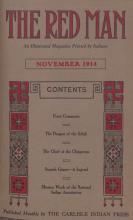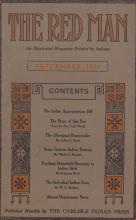The Red Man (Vol. 7, No. 3)
The press comments section covered a Supreme Court Case involving a group of Cherokees, who sought to recover interest on deferred payments. Arthur L. Stone, in the following article, told the story of the Dragon of Selish. Next, Domitilla wrote about the Stonish Giants who were defeated by the Shawnee. The following article, pulled from the St. Paul Pioneer Press, critiqued the habits of Chippewa chiefs. Another article, pulled from the same paper, covered modern methods adopted by Oklahoma Indians. Next, General Richard H.









